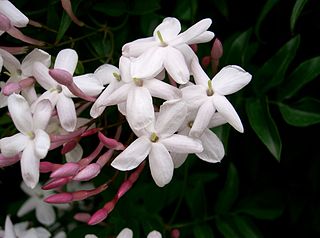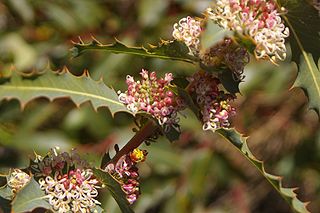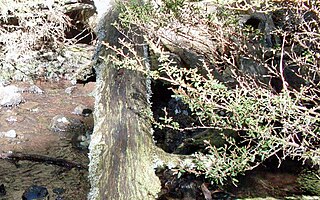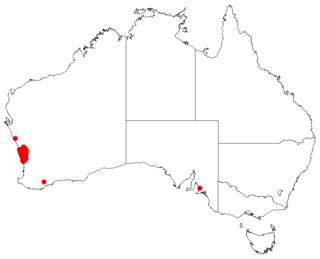
Jasmine is a genus of shrubs and vines in the olive family (Oleaceae). It contains around 200 species native to tropical and warm temperate regions of Eurasia and Oceania. Jasmines are widely cultivated for the characteristic fragrance of their flowers. A number of unrelated plants contain the word "jasmine" in their common names.

Hakea bucculenta, commonly known as red pokers, is a large shrub in the family Proteaceae endemic to Western Australia. A spectacular ornamental shrub with red or orange flowers that appear in rod-like blooms in leaf axils for an extended period from May to November.

Jasminum polyanthum, the many-flowered jasmine or pink jasmine, is a species of flowering plant in the olive family Oleaceae, native to China and Myanmar. A strong evergreen twining climber, it is especially noted for its abundant, highly fragrant pink to white flowers.

Hakea amplexicaulis, commonly known as prickly hakea, is a shrub endemic to south west Western Australia. An attractive small shrub with unusual stem clasping, sharply serrated foliage and a profusion of sweetly scented variable coloured flowers from late winter to spring.

Psychotria loniceroides, known as the hairy psychotria, is a plant native to the forest areas of eastern Australia.

Notelaea venosa is a very common shrub or small tree in eastern Australia. Occurring in or adjacent to rainforest from Lakes Entrance, Victoria to Cunninghams Gap in south eastern Queensland. Common names include veined mock-olive, smooth mock-olive, large-leaved mock-olive and large mock-olive. Often seen in the bushland areas in Sydney.

Notelaea longifolia is a very common shrub or small tree in eastern Australia. Occurring in or adjacent to rainforest from Mimosa Rocks National Park to Bamaga in far north Queensland. Common names include large mock-olive or long-leaved-olive. An attractive ornamental plant.

Hakea denticulata, commonly known as stinking Roger is a shrub tree endemic southern Western Australia. One of the many species of Australian plant described by the botanist Robert Brown. A compact shrub 1–2 m (3–7 ft) high and wide with red flowers in the spring with an unpleasant odour.

Pomaderris aspera is a plant from eastern and southern Australia. Mostly seen south of the Barrington Tops in New South Wales to as far south as Wilsons Promontory and Cape Otway on the mainland. Also occurring in Tasmania. Scattered individuals are found in northern New South Wales to as far north as Bunya Mountains National Park in Queensland.

Ochrosia moorei, known as the southern ochrosia is a rainforest plant of eastern Australia. Endangered by extinction, it has a ROTAP rating of 2ECi.

Triflorensia cameronii is a very rare rainforest plant of the coffee family, growing in a few areas of eastern Australia. Found in Lismore, New South Wales as well as a few other locations in nearby Queensland. Soils are based on basalt, and the rainforest is the drier type, with hoop pine nearby.

Leptospermum polygalifolium subsp. montanum known as the mountain tea tree or tantoon is a shrub or small tree found in eastern Australia. The original specimen was collected in 1912 near Yarrowitch. This plant is a sub-species of the Tantoon of the Myrtle family. It resembles other plants commonly referred to as "tea trees" or "paperbarks". The sub-species term montanum refers to its habitat of high altitudes. Polygalifolium is derived from Latin, referring to the resemblance of the leaves to certain members of the Polygala.
Persoonia subtilis is a plant in the family Proteaceae and is endemic to south-east Queensland. It is a spreading to low-lying shrub with many stems, branchlets that are hairy when young, linear leaves and yellow flowers in groups of up to eighteen on a rachis up to 50 mm (2.0 in) long.

Hakea adnata is a shrub in the family Proteaceae native to the south coast of Western Australia. It is multi-stemmed shrub that produces masses of white scented flowers from late winter to spring.

Hakea meisneriana is a shrub in the family Proteaceae and is endemic to Western Australia. It has small, nectar rich, creamy white flowers in clusters in the upper branches from August to November.

Hakea obliqua, commonly known as needles and corks, is a shrub in the family Proteaceae and is endemic to an area in the Wheatbelt, Great Southern and Goldfields-Esperance regions of Western Australia.

Hakea psilorrhyncha is a shrub in the family Proteacea native to a small area on the west coast in the Wheatbelt and Mid West regions of Western Australia.

Hakea recurva, commonly known as jarnockmert, is a shrub or tree of the genus Hakea native to an area in the Mid West, northern Wheatbelt and the Goldfields-Esperance regions of Western Australia.

Hakea subsulcata is a shrub in the family Proteacea and endemic to an area in the Wheatbelt, Great Southern and the Goldfields-Esperance regions of Western Australia.

Hakea grammatophylla is a shrub of the family Proteacea that is endemic to the Northern Territory, Australia. It is a variable, sparsely branched shrub with pink to reddish flowers from March to late winter.



















